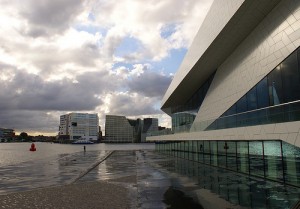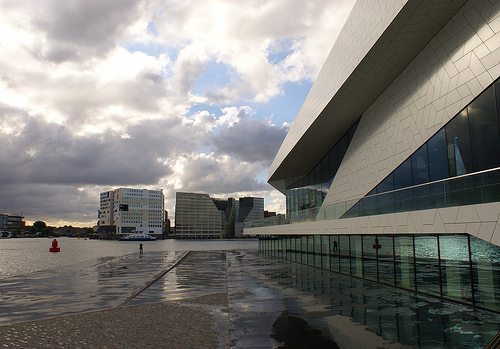 Tourists flying into Amsterdam may not notice that the map of the city contained inside their in-flight magazines is different to the one they would have encountered a year ago.
Tourists flying into Amsterdam may not notice that the map of the city contained inside their in-flight magazines is different to the one they would have encountered a year ago.
Where once the city map would have provided an overview of the arched canals, the Dam Square and the Vondel Park, one area of the city was always conspicuously missing. Amsterdam North.
The maps of a year ago extended to the river Ij and the central station, and there, as if the river presented a barrier that was insurmountable, they stopped.
Today however, the maps have shifted a few centimetres, to take in the shores of this formerly unnoticed quarter of the city.
The reason for this small shift is the presence of a spectacular new building, the wonderful film museum, known as The Eye.
From across the river, the white aluminium tiles immediately draw the eye.
The glinting tiles emphasising the dramatic extended wings that stretch out 32 meters on the south east side and 15 meters on the west.
From a distance the building resembles some origami swan coming in to land on the river bank.
That the building is an outstanding architectural feature is perhaps best illustrated by the crowds of tourists who now regularly perch on the jettys of the ferry terminals that lie behind the central station, cameras focusing in on The Eye as the mutter and wonder at this impressive structure.
I have found myself on occasion explaining to them that the ferrys they see traversing the river are actually free, and that they can easily hop on and cross to the other side to get a closer view.
A fact that never fails to elicit delighted smiles, and makes me wonder if perhaps the city can perhaps do something to promote that fact that The Eye is more accessible than it appears.
Once across the water, the building itself is full of surprises. From the inside, the sweeping staircase falls down towards the huge windows that face out onto the water and offer wonderful views of the river.
The Ij itself is a busy working river and it is very easy to pass a way a good few hours sitting on its banks watching the barges as they ferry their cargo up and down, or the small sailing boats as they make their way to the harbours or towards the north sea canal and out onto the open water.
And, of course, the enormous cruise ships that carefully navigate their way through the canal and up the river to the passenger terminal, never fail to raise gasps of awe. The sight of such gigantic vessels moving slowly over the water, dwarfing even the tallest buildings is a sight to behold.
Happily, a large terrace has been laid out under the awnings of the south east wing and will offer fantastic opportunities in summer for idling away an afternoon with a glass of beer, watching the daily dramas of the river unfold.
Of course the building itself was built as a film museum and inside it houses four film salons, an exhibition space for meetings and educational programmes, work spaces, a film laboratory and an interactive space for kids to get to grips with film making and editing.
A film buff’s paradise in other words.
What struck me most about the interior was the volume of the space inside. The huge wide open restaurant and foyer area, with those high windows opening out onto the river, should feel very imposing and lacking in intimacy, but the choice of finishings – the wood on the staircase that extends to some of the interior walls, combined with the soft lighting – seems to soften the impact of the vastness of the space, so that what could be a cavernous space, instead has a unexpected warmth.
At the opening of the building, the Austrian architects for the project, Roman Delugan and Elke Delugan-Meissl, refused to attend, following some dispute over the interior of the building.
Whatever their issue with any changes that were made to the interior prior to the opening (apparently the dispute centered on the placement of a fire door between the film salons and the foyer) the impact of the building is in no way diminished, and I looked in vain when I was there, to try and ascertain what the problem was.
For decades, the film museum in Amsterdam was snugly nestled in the Vondel Pavilion, a beautiful white building from the late 19th century.
I remember being disappointed when I first heard that this the film museum was to move to a new site in Amsterdam North. Amsterdam North! Of all places why move to such a wilderness!
How wrong headed an opinion that was. The Eye is an outstanding new architectural feature of Amsterdam and has opened up the whole riverbank for exploration and development, for tourists and inhabitants alike.
For anyone opening up their in-flight maps and spotting this new shoreline for the first time, all I can say is hop on the ferry and cross the river. It’s an eye opener in more ways than one.
